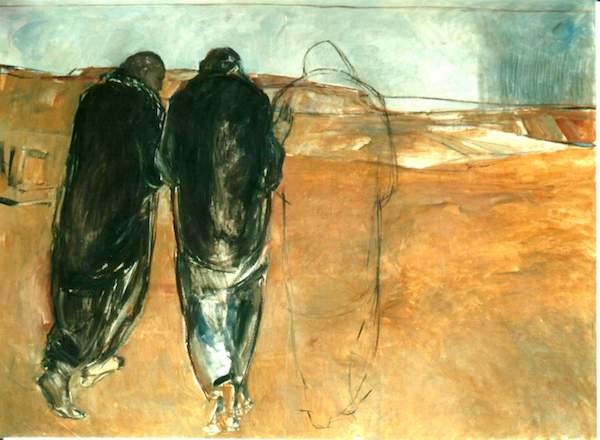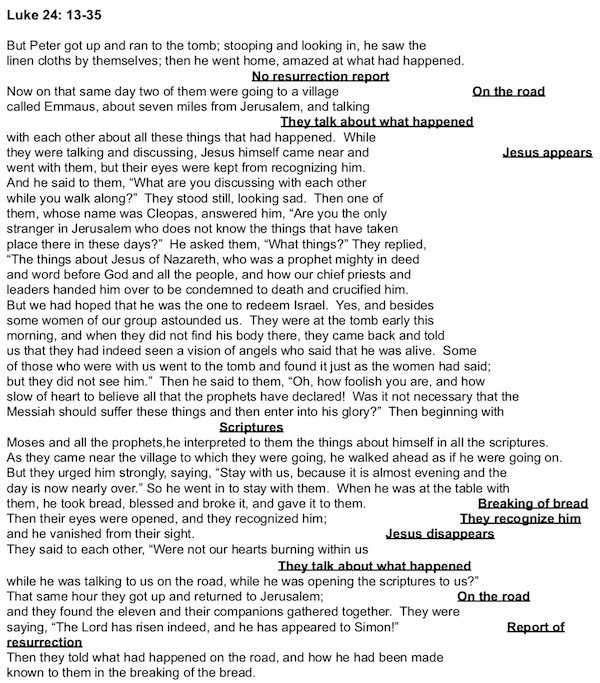Letter from Anderson, South Carolina

“The road from Jerusalem to Emmaus was about seven miles long—a two- to three-hour walk. It is a long walk when your loved one has died, or you’ve lost your job, or a relationship has been severed, or your church is shuttered. It’s a long walk when a family member or dear friend is ill or in need and you can see no way to help. It’s a long walk when all your plans, your good intentions, your dreams about how the future might look are dashed. It’s a long, long walk.”—Robin White
Wing + Prayer
By The Reverend Robin White


Editor’s Note: This column comprises a sermon Rev. White delivered, via her iPhone, to her dispersed congregation, all sheltering in place in and around Anderson, South Carolina. The sermon was titled: Roadside Reflections: To Emmaus & Back (Luke 24: 13-35).
ANDERSON South Carolina—(Weekly Hubris)—1 May 2020—Here we are again. Rather, here I am, wishing you here with me. I hope you will take a minute to read the scripture and look at the outline of it included at the foot of this column. If you will bear with me, I want to try to explain something I find fascinating about our Lectionary reading for this week, which comes from Chapter 24 of Luke.
We know that the writers of the Gospels wrote their stories about Jesus as long as 40 to 80 years after his death. The stories they compiled were not eyewitness accounts. This is important because the Gospel writers became, in essence, “preachers in their own time”; people who told stories of Jesus that reflected their own experiences, their own views and, very often, their own prejudices . . . with their own goals in mind. You are at the mercy of one preacher when you listen to a sermon. You hear the word of God through the filter of one preacher’s mind, and one preacher’s particular concerns.
This morning, we hear the words of Luke; in particular, about the experiences of two of Jesus’ followers; in particular, on the road to Emmaus. Luke is the only Gospel writer to tell this story, and I believe the “shape” of the story is very important to its interpretation. The narrative form Luke’s version takes is called the “mirror image” form, and it is one of the traditional ways in which the people of ancient Israel memorized stories and were taught the point of a story. If you look through Luke’s text, you will see that the mirror—so to speak—is held up between the Jesus’ interpretation of the Jewish scriptures and the point at which he sits down at table with the two followers for the breaking of bread. Midway through Luke’s retelling, you can see the parallels harking back to the beginning of the story and foreshadowing its end. Actually, Luke uses an even more special form here in that his narrative is an “inverted reflection.”
The text begins with Peter going home without reporting the Resurrection and ends with the two followers on the road going to Peter to report the Resurrection. At the beginning of the text, Cleopus and his companion are on the road to Emmaus, leaving Jerusalem, and, in the inverted reflection, they are on the road again . . . going right back to Jerusalem. In the first part of the text—before the pivotal moment—Jesus appears and they don’t recognize him; in the reversed reflection, they recognize Jesus, and then he disappears.
Talk about a memorable piece of prose. Luke’s story is unforgettable, once you hear it.
It is as though a mirror is placed in the midst of the story, just where Jesus interprets the scriptures and breaks bread for the two men of Emmaus, and each early element of the story finds its reflection in the end. Now, the story takes on a new dimension for us all. What takes place in the first part has its remarkable correlation in the second part.
And now, this is where this preacher gives you a sermon, and tells you the story of Jesus reflecting her own experiences, her own views, her own prejudices and biases.
What I believe is that the first part of Luke’s story is our part of the story. We have, each and every one of us, been on that stretch of road. I suspect that many of us are, at present, traveling that road and it is a long, long trek. We walk . . . in grief, in confusion, and in deep disappointment. The disciples say, “We had hoped.” Hope is in the past tense. Jesus is gone—dead and buried—and, with his death, all that they have hoped for has perished as well.
Given the magnitude of disappointment in our lives during this time of plague, the first part of Luke’s story is absolutely our story. And, like those traveling on the road in the midst of disappointment and doubt, sorrow and disillusionment, Jesus comes to us, and walks with us, and yet, like the two on the road, for whatever reason, we are unable fully to recognize him.
The road from Jerusalem to Emmaus was about seven miles long—a two- to three-hour walk. It is a long walk when your loved one has died, or you’ve lost your job, or a relationship has been severed, or your church is shuttered. It’s a long walk when a family member or dear friend is ill or in need and you can see no way to help. It’s a long walk when all your plans, your good intentions, your dreams about how the future might look are dashed. It’s a long, long walk.
As the two on the road to Emmaus walk, they reflect upon what has occurred over the course of the past several days. And then the stranger joins them, and they retell the story of all that has happened. And the stranger reflects with them and, then, reminds them of what the scriptures have proclaimed. The stranger in their midst offers them holy hindsight.
It was Kierkegaard who said, “Life can only be understood backwards; but it must be lived forwards.” Jesus, reminiscing about the scriptures, offers them the gift of memory: the memory of all that Jesus, himself, has taught them and all that Scripture has revealed.
In his book A Geography of God: Exploring the Christian Journey[ https://www.amazon.com/Geography-God-Exploring-Christian-Journey/dp/0664230725] Michael L. Lindvall[https://www.christiancentury.org/contributor/michael-lindvall] retells a story told by Archbishop Iakovos of the Greek Orthodox Church:
In a large American city, the archbishop was engaging in small talk with some families who had gathered in a sitting room. During a lull in the conversation, a three year-old walked up to him rather boldly and asked, “Can you come with me?” “Yes,” he replied. He took the archbishop’s hand and led him to the center of the room, away from the other guests. Almost before he could bend down to his level, the child put his important question to him. “How can I see God?” The archbishop replied simply, “Most often we don’t see God on the outside with our eyes. Instead, we see God on the inside with our hearts.”
In our text, Luke tells us that after Jesus vanishes from their sight, the two ask one another, “Were not our hearts burning within us while he was talking to us on the road, while he was opening the scriptures to us?”
The story from Luke is not about seeing with eyes, but, rather, about recognizing with the heart. It is knowing through experience and memory. It is mysterious but heartfelt and inescapably true remembering and knowing which transforms the way we see and hear and proceed. So, the story of the two on the road becomes our story as well as we reflect on the times and places in our own lives where we have recognized the risen Christ in our midst.
So, My Friends, we have indeed, been given the gift of memory. The memory of all that Jesus teaches us and reveals to us through scripture. Memory that forged the identity of those early followers and forges our identity even now. In an expository article entitled, “Burning Hearts,” in The Christian Century, Peter Marty[https://peterwmarty.com/] quotes professor and preacher Craig Dykstra[https://divinity.duke.edu/faculty/craig-dykstra]:
Without a narrative that sustains us, the world—and we, ourselves—are virtually phantoms. But the issue is not just whether one has a narrative or not. The issue is whether we have one that is true and genuine, one that can sustain us in reality, one that, having been given and committed to memory, frees us from desperately having to make one up.
I have the great fortune to have a genuine and true narrative burning in my heart—the gift of memory that sustains me during these difficult days. The eyes of my heart recognize the Christ in you all.
This is our story. Whether we persist in our grief, in our disappointment, or come away from Emmaus with a new way of “living forward while understanding backwards” will be determined by how we respond to the gifts we receive on the path.
There is an old tale of a city fellow who arrives at a fork in the road in the country. Signs at the intersection point to his destination . . . in both directions. Undecided about which way to turn, the man shouts to a nearby farmer out working in his field: “Hey, does it make any difference which road I take?”
The old man shouts right back, “Not to me, it don’t!”
In the midst of darkness and uncertainty, it may not be a big deal to some which road we take. But, like the two disciples at Emmaus, we have been given the gift of memory, the gift of recognition, the gift of hindsight by way of reflection and, at the same time, the gift of foresight as regards our ultimate destination. The way we travel from this point forward matters a great, great deal.
![]()
